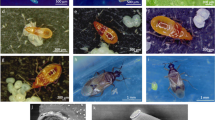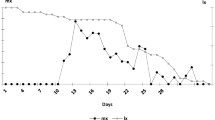Abstract
This paper reports on the morphology, biology and pesticide tolerance ofCheletogenes ornatus (Canestrini & Fanzago), the most common predator ofPinnaspis aspidistrae (Signoret) in the region of Juazeiro-Bahia-Brazil. Some differences betweenC. ornatus from Brazil and redescriptions in the literature are mentioned in this paper. At 28±5°C the duration of the life cycle was 40.6 and 31 days for ♂♂ and ♀♀ respectively. Females had 2 nymphal stages while the only male obtained in the laboratory had a single nymphal stage.C. ornatus reproduced by thelytokous parthenogenesis, and ♀♀ were seldom produced. The peak reproduction rate wasca. 0.31 eggs/♂/day, and the peak prey comsumption rate wasca. 0.8 crawler ofP. aspidistrae/♂/day. The least harmful chemicals to adult females ofC. ornatus were methyl parathion, malathion, cyhexatin, zineb and sulfur. Those chemicals caused less than 20% mortality of ♂♂ at the recommended rates on citrus. Concurrently, the first 2 chemicals caused over 70% mortality of crawlers ofP. aspidistrae in the laboratory at the recommended rates.
Résumé
Ce travail rend compte de la morphologie, de la biologie et de la résistance aux produits phytosanitaires deChelotogenes ornatus (Canestrini & Franzago), prédateur le plus fréquent dePinnaspis aspidistrae (Signoret), dans la région de Juazeiro-Bahia-Brésil. Quelques différences rencontrées entre les échantillons deC. ornatus récoltés au Brésil et les descriptions de cette espèce relevées dans la littérature sont également mentionnées. A 28±5°C, la durée totale des stades immatures fut de 31,0 jours pour les ♀♀ et de 40,6 jours pour les ♂♂. Ces dernières ont présenté 2 stades nymphaux alors que l'unique mâle obtenu au laboratoire n'en a présenté qu'un seul.C. ornatus s'est reproduit par parthénogénèse thélytoque et, en conséquence, les mâles apparaissent rarement. Le niveau maximum de reproduction a été de 0,31 œufs/femelles/jour tandis que la consommation maxima de proie a été de 0,8 larves mobiles deP. aspidistrae/femelle/jour. Les pesticides les moins toxiques pour les ♂♂ adultes deC. ornatus furent le parathion méthyl, le malathion, la cyhexatine, le zineb et le soufre. Ces produits ont causé moins de 20% de mortalité chez les ♂♂ deC. ornatus, aux concentrations recommandées pour le traitement des citrus, alors que les 2 premiers pesticides cités ont entraîné la mort de 70% des larves mobiles deP. aspidistrae aux mêmes concentrations, en laboratoire.
Similar content being viewed by others
References
Anonymous. — 1968. First conference on test methods for resistance in insects of agricultural importance. Method for the boll weevil and tentative method for spider mites. —Bull. Entomol. Soc. Am., 14, 31–37.
Arruda, G. P., Oliveira, A. A. & Flechtmann, C. H. W. — 1969. Acaros associados a plantas no Nordeste do Brasil. — Resumos de 11a. Reuniao Anual da Sociedade Brasileira de Entomologia, Recife, pp. 35–36.
Avidov, Z., Blumberg, D. &Gerson, U. — 1968.Cheletogenes ornatus [Acarina: Cheyletidae], a predator of the chaff scale on citrus in Israel. —Israel J. Entomol., 3, 77–93.
Baker, E. W. — 1949. A review of the mites of the familyCheyletidae in the United States National Museum. —Proc. U. S. Nat. Mus., 99(3238), 267–320.
Smiley, R. L. &Whitaker Jr., J. O. — 1981. Studies on the idiosomal and leg chaetotaxy of theCheyletidae [Acari] with descriptions of a new genus and four new species. —Int. J. Acarol. 7, 109–127.
Summers, F. M. &Price, D. W. — 1970. Review of the mite familyCheyletidae. —Univ. California Press, Berkeley, 61, 153 p.
Yousef, A., Zaher, M. A. &Kandil, M. M. — 1980 (1979). Comparative morphological studies on the development stages ofChelotogenes ornatus (C. & F.) [Prostigmata: Cheyletidae]. —Acarologia, 21, 228–233.
Zaher, M. A. &Soliman, Z. R. — 1971. Life-history of the predatory mite,Cheletogenes ornatus (Canestrini and Fanzago). —Bull. Soc. Entomol. Egypte, 55, 85–89.
Zaher, M. A., Yousef, A. E. A. &Kandil, M. M. — 1981. Effect of food on the biology ofCheletogenes ornatus (C. & F.) [Acari: Prostigmata: Cheyletidae]. —Acarologia, 22, 361–366.
Author information
Authors and Affiliations
Rights and permissions
About this article
Cite this article
de Moraes, G.J., Neto, R.S. & Pinto, H.C.S. Morphology, biology and pesticide tolerance ofChelotogenes ornatus [Acari: Cheyletidae] . Entomophaga 34, 477–484 (1989). https://doi.org/10.1007/BF02374385
Received:
Accepted:
Issue Date:
DOI: https://doi.org/10.1007/BF02374385




